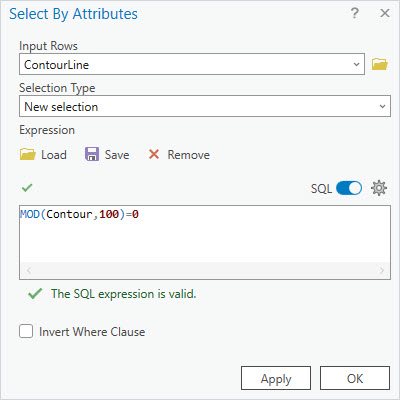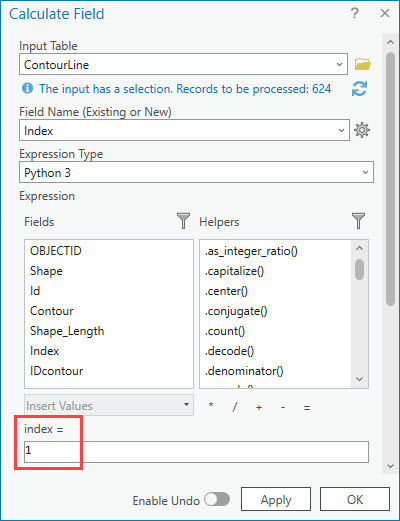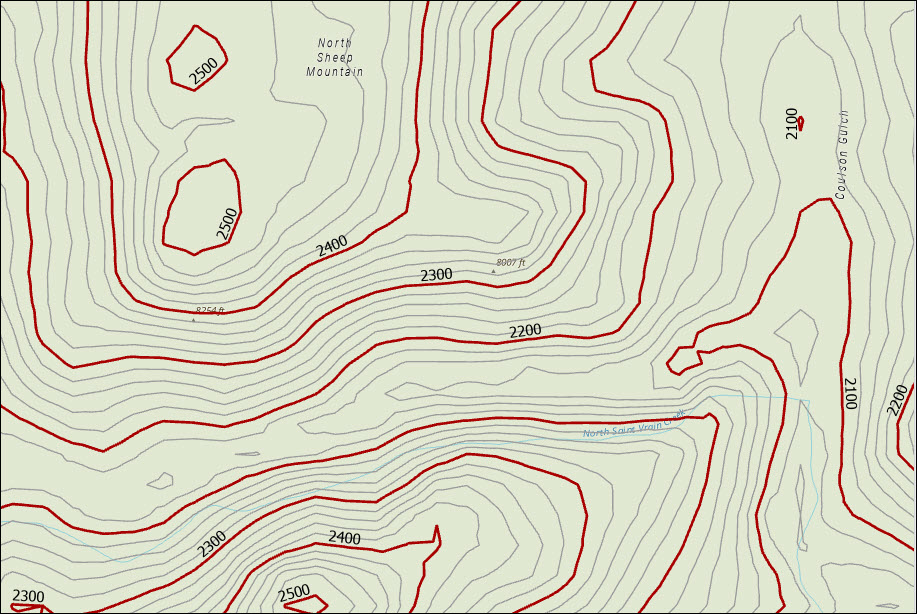HOW TO
Create and symbolize index contours in ArcGIS Pro
Summary
Index contours are commonly used as a cartographic aid to assist in the visualization of contour lines. In a contour map, index contours are usually symbolized with a thicker line symbol to differentiate the index contours from intermediate contours. This article provides two workflows to create index contours with different input data types; the first option requires a vector contour line feature layer, and the second lists the tools that require a raster dataset or an elevation surface layer as the input.
Procedure
Create index contours using the Select By Attributes tool
This option uses the Select By Attributes tool to select the index contour lines from a contour feature layer based on the desired index interval. A unique value is assigned to the selected index contours to differentiate the symbology between index contours and intermediate contours.
- Add a new field to the contour layer, and select Short for Data Type. In this example, the new field is Index.
- Select index contours from the contour layer using the Select By Attributes tool.
- On the Map tab, in the Selection group, click Select By Attributes
 .
. - In the Select By Attributes dialog box, for Input Rows, select the contour layer from the drop-down list.
- Toggle SQL on to display the SQL expression box.
- Insert the following SQL expression in the expression box. Replace <elevation_field> with the field containing the elevation values, and <interval> with the desired index interval value.
- On the Map tab, in the Selection group, click Select By Attributes
MOD(<elevation_field>,<interval>)=0
- Click Verify
 to validate the expression.
to validate the expression. - Click OK.

Note: Usually, index contours are every fifth contour. If the contour interval of a contour layer is 20 meters, use an index interval value of 100 to create an index contour for every fifth contour. The index interval value must be evenly divisible by the base contour value.
- Assign unique values to the index contours and intermediate contours in the contour layer.
- In the Contents pane, right-click the contour layer and click Attribute Table.
- In the attribute table, click Show Selected Records
 to view the features selected in Step 2.
to view the features selected in Step 2. - In the selected records view, right-click the new field created in Step 1 and click Calculate Field.
- In the Calculate Field dialog box, enter 1 in the field parameter to assign the unique value '1' to all index contours.

- Click Apply and click OK.
- In the attribute table, click Switch
 to switch the selection to intermediate contours.
to switch the selection to intermediate contours. - Repeat Steps 3(c) through 3(e), and enter 2 in the field parameter to assign the unique value '2' to all intermediate contours.
- Click Clear Selection
 .
.
- Symbolize the contour layer using the assigned unique values to differentiate between index contours and intermediate contours.
- In the Contents pane, right-click the contour layer and click Symbology.
- In the Symbology pane, select Unique Values for Primary Symbology.
- For Field 1, select the field containing the unique values. In this example, the field name is Index.
- Customize the symbology for each value as desired.
The map shows index contours at 100-meter intervals displayed in red, and intermediate contours displayed in gray.

Configure the index interval parameter in the tool when converting data to contour lines
ArcGIS Pro provides several tools to process elevation data and generate contour information. The Contour with Barriers, Identify Contours, and Generate Topographic Contours tools require a raster-based elevation layer as the input data, while the Surface Contour tool requires an elevation surface layer such as a terrain dataset. These tools include an index interval parameter to generate index contours at specific intervals in the output feature layer. When specified, the index interval parameter creates an additional field in the output feature layer with unique codes to differentiate the index contours from other contour types. The table below compares four tools that create or update a contour feature layer with index contours.
| Tool | Contour with Barriers | Surface Contour | Identify Contours | Generate Topographic Contours |
| Input data | Raster Layer; Raster Dataset; Mosaic Layer; Mosaic Dataset | LAS Dataset Layer; Terrain Layer; TIN Layer |
Contour: Feature layer Raster: Raster Layer; Mosaic Layer |
Contour: Feature Layer Raster: Raster Layer; Mosaic Layer |
| Output data | New contour feature class | New contour feature class | Updated feature layer | Updated feature layer |
| Tool usage | Creates contour lines from a raster surface. | Creates contour lines derived from a terrain, TIN, or LAS dataset surface. | Identifies contour types and applies hypsographic codes to input features. The input feature layer is updated with contour codes. | Creates and smooths contours from an input raster. The input feature layer is appended with new contour lines. |
| Index contour parameter |
Indexed Contour Interval Index contours are generated from the entered interval value. Index contours are coded as 2 in the Type field generated in the output feature class. |
Index Interval Index contours are generated from the entered interval value. Index contours are coded as 1 in the field generated by the Index Interval Field parameter. |
Contour Index interval Index contours are generated from the entered interval value. The default is 100. By default, index contours are coded as 1 in the field selected in the Contour Code field parameter, unless modified in the Index Code parameter. |
Contour Index Interval Index contours are generated from the entered interval value. By default, index contours are coded as 1 in the field selected in the Contour Code Field parameter, unless modified in the Index Code parameter. |
| Extension |
Basic: Requires Spatial Analyst or 3D Analyst Standard: Requires Spatial Analyst or 3D Analyst Advanced: Requires Spatial Analyst or 3D Analyst |
Basic: Requires 3D Analyst Standard: Requires 3D Analyst Advanced: Requires 3D Analyst |
Basic: No Standard: Requires Production Mapping Advanced: Requires Production Mapping |
Basic: No Standard: No Advanced: Requires Production Mapping and ArcGIS Spatial Analyst extension |
Article ID: 000018881
- ArcGIS Pro 3 1
- ArcGIS Pro 3 0
- ArcGIS Pro 2 9x
Get help from ArcGIS experts
Start chatting now

